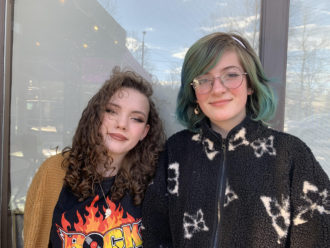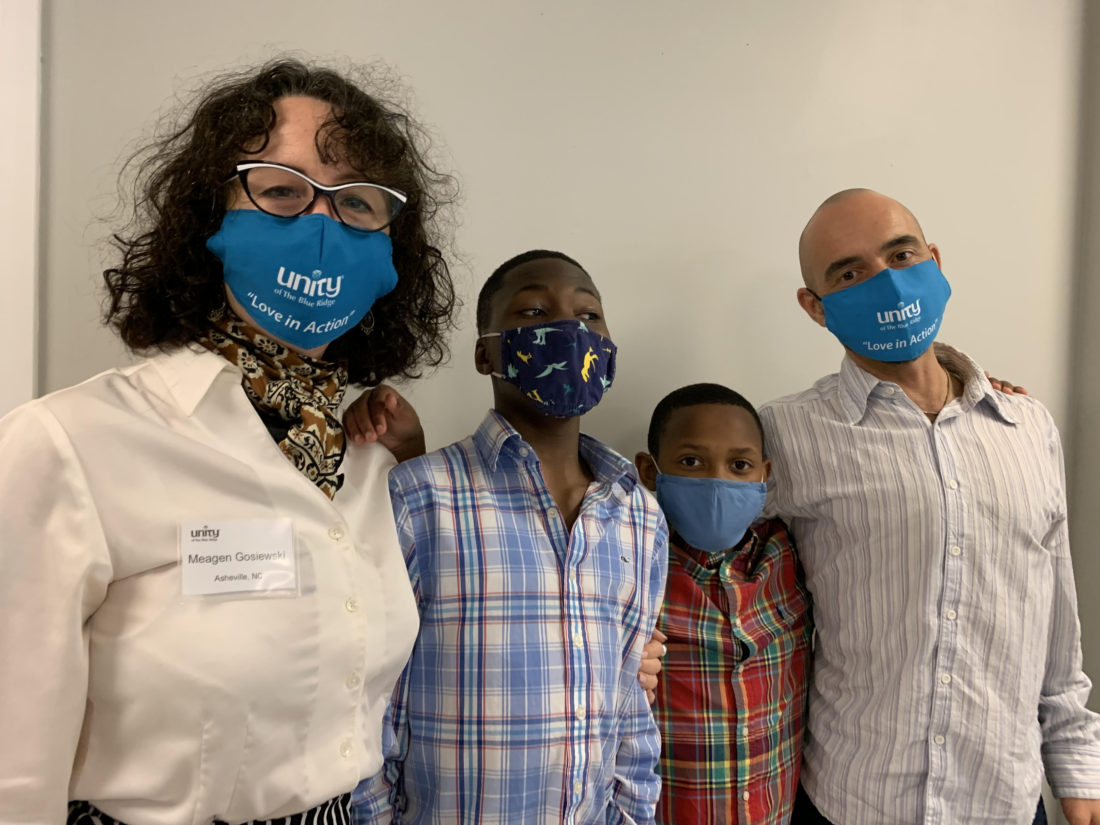Asheville mom Elizabeth Callahan turned the early days of the COVID-19 pandemic into an adventure for her two teens. “It was exciting at first,” she says. “We went for hikes and did art projects.”
But as the days wore on and turned into weeks, months and years, she says things changed.
“Hope of it ending soon drifted away. We couldn’t keep up the energy. And after a while, when we tried social stuff, keeping distance and wearing masks, that was when it became real, and they couldn’t act like children,” she says of her kids.
“We’re getting the hard stuff now as we’re shutting down again. After a short period of somewhat returning to normal, they know even more what they lost, and it feels so much harder. Now they panic; they just can’t do it again,” Callahan continues.
When her 14-year-old daughter, Julia Helen, got COVID-19 in January, Callahan says her daughter was really scared and shut herself in her room. “[Teens] just feel things more,” Elizabeth says. “I just let her feel her feelings.”
Elizabeth’s son, Henry, was 15 when the pandemic first hit and says the only thing that’s kept him sane the past two years is the support of his best friend and girlfriend. “Isolation really affected a lot of my peers,” he says. “People were lonely.”
Now a junior at the School of Inquiry and Life Sciences at Asheville, Henry says, “Everyone is hanging on for dear life.”
Teens in crisis
Asheville’s adolescents aren’t alone in feeling isolated and overwhelmed by the pandemic. According to the federal Centers for Disease Control and Prevention, the percentage of emergency department visits involving mental health among children ages 12-17 increased 31% from 2019 to 2020. And ED visits for suspected suicide attempts, especially among girls, have continued to increase over pre-pandemic numbers.
N.C. Department of Health and Human Services data shows similar trends. While the overall number of ED visits was lower in 2020 than in 2019, potentially due to people avoiding hospitals out of COVID-19 concerns, the proportion of visits by teens with thoughts of suicide increased. Among kids ages 10-14, suicidal ideation visits accounted for 3.5% of all ED visits in 2020, up from 2.4% in 2019.
Laura Anthony, a licensed clinical social worker and therapist in private Asheville practice, says that social isolation is the No. 1 issue plaguing teens during the pandemic. Through her work with children, adolescents and adults struggling with depression, anxiety and trauma, she finds that “screen time increased drastically for most teens.”
“Their connection to the outside world became social media, and it’s not real,” she says. “Already plagued with low self-esteem, they compare themselves and their lives to the selfies of their peers.”
Anthony says that therapy is vital for struggling teens, especially those in danger of self-harm or hurting others. But while she says Asheville hosts many therapists, most parents can’t arrange appointments for their kids.
“Therapists’ schedules are full, and many have waiting lists. If my schedule is full, I try my best to refer to another therapist, but that’s not always possible,” Anthony says. “In my opinion, there are not enough therapists available to work with our troubled teenage population.”
Added pressure
Meagan Gosiewski is a licensed therapist and mental health counselor employed by the state of North Carolina. Even with all her training, the Asheville mother and her husband, Michael, have struggled with the continuing challenges of raising two middle school boys during the pandemic.
Their first issue was getting the Buncombe County school system to acknowledge the extra fear and anxiety exhibited by Ian, 13, who is in the exceptional children program with intellectual and developmental disabilities.
“He was bedwetting frequently during lockdown, and there was a lot of back-talking and acting out,” Gosiewski said. “He lost all the progress he’d made in his reading, so we wanted to hold him back a year. It wasn’t their policy, but we persisted until they agreed.”
The Grosiewskis adopted Ian and his brother, Marcus, now 11, when they were infants. Meagan says that she and Michael tried hard to take the fear aspect out of the pandemic for their children. But when coronavirus-related deaths hit close to home, it was hard to lessen their grief.
“We had a full-time caregiver for Ian for five years,” Gosiewski says. “She went home sick one day and was dead from COVID within a week. That was really hard. And then we lost five other close friends and family members to the virus.”
Now, when Marcus hears his friends repeat anti-vaccine sentiments they heard from their parents, he just ignores them. He told his mother he wanted the vaccine as soon as he could get it.
Dealing

Veda Sands, 13, and Story Lee, 14, are best friends and classmates at Evergreen Community Charter School. Both agree that social isolation has been their most difficult challenge since the beginning of the pandemic. They are grateful they have each other and a handful of other close friends.
“It’s better to have some people you can count on,” says Sands. “If a friend you trust is having an issue, just being there for them can be enough.”
Both teens say they’ve seen tremendous struggles and drastic changes among their peers. “I’m seeing a lot of anxiety and depression among my other friends,” says Lee. “I have three close friends who’ve made suicide attempts. One was admitted to a psych ward, one stabbed herself, and another used a razor.”
Lee says that she’s taken to wearing makeup as her form of release and credits her therapist as helping her deal with the new feelings she’s experiencing. After spending eight months on a waiting list to get her first appointment, she’s glad she finally got the help she needed. “I’m learning more coping mechanisms and how to deal with friends and realizing middle school won’t last forever,” she explains.
In addition to mental health issues, the two teens see the proliferation of texting as a negative consequence of social isolation. “We hear more about people self-harming,” says Lee. “And it does take some of the urgency out of it when you’re not with the person, reading their body language and seeing how serious they are, because some people do say things just for attention.” She says that the pressures of the past two years have forced them to grow up faster than they would have “without facing issues like the pandemic and [protests following the police murder of] George Floyd.”
As part of the coping mechanisms among their peers, they’ve seen a big uptick in experimentation with drugs, alcohol and nicotine vaping.
Lee says that drugs, alcohol and vaping are getting more popular at younger ages. “And it doesn’t help that shows like Euphoria [an HBO series] and other movies glorify mental illness and drugs.”
Sands says that sometimes she’s shocked at seeing friends pick up these habits. “It’s people I never thought would do those things,” she says. “I wonder — how can a pandemic change you so much?”
Bottom line: “Life is harder than we expected it to be at this age,” says Lee.
Grappling with solutions
To better deal with the emotional turmoil, teens need something to do after school, says Carolina Day School middle school art teacher Mike Congleton. “Teenage suicide has always been a thing, but isolation is adding to this. Kids who isolate even more during the pandemic are the ones I worry about the most.”
In addition to falling behind in school, “kids’ imaginations run to the negative” when they don’t have anything to do, Congleton adds. “And phones and tech just make them more anxious.”
Congleton, also an artist with a studio in Grovewood Village, says teens need ways to express their anxiety. Lately, he’s found that “kids are being more fearless with their art. They’re expressing their rebelliousness, their fears and their anger. The therapy of art is a healing thing for many kids. I’ve always seen that art is a way to release stress and anxiety.”
Congleton adds that dance and theater are great avenues for teens to get involved with other people in real life while using art as a way to relieve stress. He points to Saturday and evening programs at the Asheville Art Museum and online and in-person workshops at Asheville-based Roots + Wings School of Art and Design as positive, age-appropriate outlets.
Anthony, the Asheville therapist, says teens who find safe ways to spend time with their peers fare better than those who stick to screens for social interaction. “Even during the pandemic, some schools have continued to engage kids in team sports. Outside activities are safer, but amazingly, some teenagers tell me they have enjoyed playing sports inside while wearing a mask,” she says.
“All through the pandemic, I know teens who have gone to gymnastics, dance classes, martial arts, chorus, marching band, drama and acting classes,” Anthony continues. “I believe that being active and involved in community is necessary for healthy development.”




Before you comment
The comments section is here to provide a platform for civil dialogue on the issues we face together as a local community. Xpress is committed to offering this platform for all voices, but when the tone of the discussion gets nasty or strays off topic, we believe many people choose not to participate. Xpress editors are determined to moderate comments to ensure a constructive interchange is maintained. All comments judged not to be in keeping with the spirit of civil discourse will be removed and repeat violators will be banned. See here for our terms of service. Thank you for being part of this effort to promote respectful discussion.